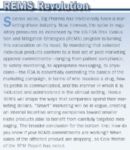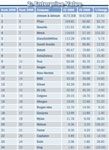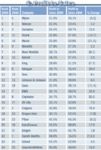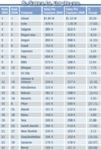Pharm Exec's Ninth Annual Industry Audit
Professor Bill Trombetta takes a snapshot of the "Glamour 24" companies shaping the pharma industry this year and beyond
Pharm Exec's Ninth Annual Pharma Industry Audit, prepared by Professor Bill Trombetta of the Erivan K. Haub School of Business at St. Joseph's University, portrays this year's roster of 24 companies as a puzzle—with a big missing piece. While the 24 continue to generate lots of cash along with healthy profits, measurable gains in the key marker of overall Enterprise Value remain elusive. Despite improvements in the Audit's eight performance metrics against last year's recessionary downturn, the top weighted Enterprise Value to Sales (EVS) ratio for the group is stuck at a paltry 3.24 percent. Compare that to Facebook, with few tangible assets beyond a technology platform, but with an EVS multiple of 30 times sales.

GETTY IMAGES / DAVID MALAN
One explanation for the gap between strong revenues, high profits, and the low estimation of real value is the dead weight of uncertainty imposed by larger structural trends buffeting the industry. These include the patent cliff, lagging R&D productivity, more crowded therapeutic categories, phase-in of US health reform, and slower uptake of new products due to reimbursement pressures. Equally evident is that industry efforts to build a better value proposition—through consolidation and aggressive cost-cutting—is not a sustainable strategy for the long term. Hence the gnawing question: What will it take to put more "jig" in the jigsaw for puzzled investors?
This year's Audit is a study in continuity. Once again, one of our "stealth pharma" companies (see Pharm Exec's June 2009 issue, for a full profile of this group) takes the top honor, with Gilead repeating its win from last year with a tightly focused therapeutic franchise and formidable cost controls, reinforced by a strong Profit to Sales ratio. As it happens, the Audit's findings are reinforced by Pharm Exec's cover story in this issue on Gilead (in this isuue), its strategy, and line management.
Notching a close second is the specialty biotech firm Celgene, a first-time runner-up due to its stellar performance on that crucial metric of Enterprise Value. In third is Biogen-Idec, repeating its placement from last year. The company continues to lead in therapies that can be priced to the market, with high unmet medical need and less competition.

REMS Revolution
A key lesson from this year's Audit is that staying lean makes you a mean competitor. Clearly, the smaller companies among the 24 carry an advantage in the rankings due to their ability to target and fill discrete market segments with niche products that carry a price premium, with fewer of the fixed overhead obligations (including a large sales force) required to prevail under the blockbuster model. While the Big Pharma giants, led by Pfizer and Merck, did score solid improvement in metrics that measure efficient management of costs and assets, our stealth pharma competitors as a whole did better—perhaps because smaller ships can steer faster through a turbulent business current and are quicker to recognize when ballast turns to bloat. But don't count the big players out. Size and a large cash hoard can provide cover for a raft of product failures, operational inefficiencies and strategic false starts while providing the resources to compete in a high-risk business where success requires global scale and reach. — William Looney, Editor-in-Chief
This year's Audit analyzes the calendar year 2009 performance of 24 publicly traded companies that file 10-K or 20-F reports on an annual basis with the US Securities and Exchange Commission. As in past years, the Audit includes a wider array of performance metrics than found in the standard financial and accounting statements. Drawing on this larger set of sources allows for a more meaningful picture of performance, analyzing such key metrics as Enterprise Value in Proportion to Sales—a critical portent of future prospects that focuses on profitability growth through product and process innovation.
In addition to the 10-K and 20-F reports, the Audit relies on proprietary and non-proprietary databases, as well as a broad array of secondary sources ranging from the business press to investor reports. Every effort is made to apply these sources uniformly to each company surveyed; this year, however, data on Novo Nordisk was derived exclusively from Dailyfinance.com and market capitalization rather than citing Enterprise Value due to the company not supplying its figures to Yahoo Finance as the Audit was being completed.
The key difference in this year's Audit is a reduction in the number of companies examined from 27 to 24, due to three significant M&A transactions: the acquisition of Wyeth by Pfizer, and Schering-Plough by Merck, as well as the transition to full ownership of Genentech by Roche. It should be acknowledged that consolidation has enhanced the weight of the 10 stealth pharma companies included in the Audit roster.
The Pharma Industry Audit is also uniquely positioned to demonstrate whether a company's business strategy is actually enhancing shareholder value. If there is one metric that's equivalent to food and water on a desert island, it's Enterprise Value. In the case of management, the measurement of success is simple: Do you create shareholder value or destroy it? For this reason, the Audit gives highest priority to just two metrics: Change in Enterprise Value and Enterprise Value to Sales. These numbers reflect a firm's market capitalization plus liabilities minus cash, or about what it would take to buy the firm on the open market. The Return on Assets metric is another worthy exemplar of a commitment to long-term profitability, and thus is given significant weight in the Audit.
The rating formula covering the eight metrics reflects the fact that some aspects of company performance are more important than others. Three of the metrics, covering value recognition and asset performance, are weighted at three; while the remaining five metrics are weighted at two. Two other metrics are not weighted; these are basic macro indicators covering scale and size that allows for viewing company performance in the context of overall industry trends.
Thus, determination of the final standing for each company relies entirely on the metrics—but not all metrics are equal. For example, if a company places 10th out of 24 on a metric weighted at three, it receives (10 x 3), or 30 points. Each company's points across all of the metrics are then totaled for a final score, with the company receiving the highest number of points overall designated as Company of the Year.
Macro Benchmarks: Sales and Sales Growth
Total sales and sales growth are two indicators that provide a window on overall market conditions facing the entire sector, from Big Pharma to the smallest biotech. There was little change over 2008 in the rankings of the 24 in terms of size (see Table One). The top three—Johnson & Johnson, Pfizer, and Novartis—remain, while AstraZeneca, Abbott, and Merck posted higher sales sufficient to move up the ranks, to fourth, fifth, and eighth, respectively. Sanofi-Aventis, Glaxo-SmithKline and BMS each dropped a notch, taking sixth, seventh, and tenth place.

1: Annual Sales
Among stealth pharma, Gilead achieved the biggest gain, pushing sales up 31 percent over 2008, to occupy 14th place, followed by generic powerhouse Teva at 25 percent, putting it in the 12th spot.

Audit Data Sources and Key
Do I Hear Emerging Markets?
Overall, the group averaged sales growth of only 6.6 percent over 2008, better than last year but low from a historical point of view. The trend reflects the anemic economic prospects and harsher reimbursement climate in the mature markets of the US, Europe, and Japan. Still, the performance is generally in line with IMS data that pegged drug sales at 7 percent growth worldwide last year. With most of the forecast expansion in sales now slated to take place in emerging markets, those among the 24 that possess global reach should be in a position to benefit. IMS is also predicting an uptick in US market growth after 2013, as the patent cliff erodes and the expansion of insurance cover under health reform is phased in. Hence, we can safely conclude that the sales are for the taking, but the competition to attract skeptical customers with a fresh value proposition will be more intense.
With this as the background context, let's review the details driving results for the 24 surveyed companies.
Enterprise Value: The Indispensible Metric
As noted, this is the Holy Grail in the race to improve the kind of performance that moves share price. Enterprise Value reflects the true value of a company based on its market capitalization—expressed as common stock shares outstanding—at the posted stock price, plus cash assets minus debt. It closely tracks the size of a firm's gross sales. (See Table Two for Enterprise Value rankings of the 24 Audited companies.)

2: Enterprise Value
The important caveat in presenting a true picture of performance is how that value is created—or destroyed. For example, Pfizer and Merck scored the biggest gains in Enterprise Value over 2008, moving up from fifth to second and from seventh to fourth, respectively. But most of this was linked to the one-time boost in sales associated with merger activity rather than the kind of permanent organic growth driven by new products, improved business processes, or other changes that demonstrate real added value to the customer.
Teva, BMS, Allergan, Watson, and Endo notched progress on this metric, though not at the pace of Pfizer and Merck. As these companies moved forward, GSK suffered the biggest downward shift, from second in 2008 to fifth place this year, followed by Sanofi-Aventis, which went from fourth to sixth. Both companies have hassled with regulators over key portfolio products that depressed share price to the point where, at least for now, neither is considered a "growth" stock. Significantly, the only two among the 24 to score an actual negative in Enterprise Value were in the stealth pharma segment: Cephalon and King, declining 4.2 percent and 10.1 percent, respectively, against their 2008 performance. Through much of the past year, the two companies faced generic threats due to pending patent expirations and enforcement disputes.
The second metric weighted at a hefty three is Enterprise Value to Sales, listed here as Table Three. This metric normalizes the differences in scale due to absolute dollar revenues and is thus a more accurate barometer of future capacity to grow sales and profits—the higher the ratio, the more impressive the performance. Celgene and Gilead posted the best ratio, retaining their leads from last year. Celgene, in particular, has a stiff wind in its sails with a strong oncology portfolio led by its $2 billion-plus blockbuster Revlimid, for multiple myeloma. Strategically savvy acquisitions promise to expand this therapeutic franchise, and investors have been slow to discover the advantages in the stock. Gilead, while retaining its No. 2 position on this key metric, did less well in 2009 than previously—its EVS ratio fell from 7.48 to 6.03—due to the financial impact of costly investments in portfolio diversification. It's a possible indicator of trouble ahead as generic challengers contest its leadership position in HIV.

3: Enterprise Value to Sales
Pfizer, in contrast, scored a dramatic gain in the overall ranking, moving up the list from 19 in 2008 to ninth this year, but this is largely due to the temporary windfall impact of the merger with Wyeth. Merck evidenced a similar, but not as dramatic, jump.
Gross Margin: Free to Price is Key
Gross Margin is cited in Table Four for each of the 24, along with the rate of increase between 2008 and 2009. Gross Margin is important as it portrays a firm's pricing power, in terms of the ability to increase prices or maintain them against an increasingly powerful and demanding payer base. In other words, the higher the Gross Margin, the better handle the company has in managing the market and keeping shareholders happy through solid profit growth.

4: Gross Margin
Overall, the numbers show companies with a focus on specialty medicines that encounter little competition in their therapeutic category can continue to reap very high rewards. Once again, the best firms in 2008—Celgene and Biogen-Idec—came out on top, with Gross Margins in excess of 90 percent. Both are heavily focused on niche specialty markets. Ten of the 24 posted lower Gross Margins this year against 2008, reflecting the growing ability of payers to dictate the terms on pricing in therapeutic areas characterized by numerous follow-on products.

Teva: The Big Disrupt
But the real surprise is the still hefty 53 percent performance of the leading generic producer, Teva. Even though the number was slightly down against 2008, it serves as a counter to the notion that the generics segment is a low-margin business—a view clearly not shared by Teva management.
Profit Metrics
Next, we move to Profits (Table Five)—mother's milk to shareholders. Profits tend to show what remains after operating expenses are subtracted from gross margins. Thus, Profits can be positively influenced by effective control of costs. This in turn drives larger financial performance measures built around EBITDA—earnings before interest, taxes, depreciation, and amortization. In essence, EBITDA determines the level of Profit against Sales. The higher this ratio, the more impressive a firm looks to the investor community. Table Six shows that, all told, the 24 averaged a Profit Ratio of around 34 percent—not as high as in the past, but an enviable benchmark against other industries. Again, Teva refutes the idea that generic company margins are razor thin in comparison to the innovative sector, with a Profit Margin of 30.8 percent, or just below the average—and surpassing the performance of Big Pharma innovators like Novartis, Abbott, and Merck. However, most of the Big Pharma players did well in the category too, including Pfizer, Sanofi-Aventis, and especially GSK.

5: Profit to Assets
Sales to Assets: The Drive for Productivity
How Sales relate to Assets is another factor that drives profitability, but it is most useful as an indicator of operational productivity. It showcases what management can do in leveraging efficiencies executed under its own control, rather than being a hostage to pricing decisions determined largely by external actors. Table Seven indicates how a firm's productivity changed from 2008 to 2009 in relation to sales revenues, divided by the assets held on its books. The higher the ratio, the more productive a firm is over the course of the year.

6: Profit to Sales
The majority of this year's group—19 out of 24 companies—struggled to keep pace on this metric in 2009, scoring lower ratios against our results for 2008. The winner was Novo Nordisk, with a Sales to Assets ratio of 0.934, which means that for every dollar it invested in Assets, the company returned 93 cents in Profit. With public and private budgets for medicine under strain due to the fiscal crisis in mature markets, the 24 have no choice but to keep focusing on how to wrest more gains from asset investments. The winners will be those with A) a good pricing strategy; B) a portfolio directed to the therapeutic areas where there is an unmet medical need; and C) management that knows its business and has the execution skills to get the most from key investments in product and operational support and services.

7: Sales to Assets
Finally, Profit to Assets is a stronger metric than either Profit to Sales or Sales to Assets on its own. GSK and Gilead performed best on this metric, although the trend line on Gilead is down. Both showed that strong management led to a maximization of profit margins—a key interest of shareholders.
Sales to Employees: Job Cuts Set the Pace
- A final criterion around productivity is the ratio of Sales to Employees (Table Eight), which is a metric of growing importance now that the industry is finally shedding large parts of its workforce. An estimated 35,000 positions in pharma and biotech have been cut so far this year, while Pfizer and Merck ranked seventh and eighth, respectively, in a recent Wall Street Journal list of 25 big US multinationals posting the largest job cuts during the recent recession.

8: Sales to Employee
As a result, most companies, with sales posting healthy growth, were able to improve their performance on this metric. Not surprisingly, specialty and biotech firms, with modest sales overhead and an ability to price to the market, outperformed the Big Pharma companies. Gilead again took top honors, far outpacing the pack, with a Sales per Employee number in excess of $1.8 million—twice as high as the runner-up, Endo. Conversely, Merck suffered the biggest drop in the ratio as it struggled to absorb staff from Schering-Plough. Genzyme's performance also lagged, as a consequence of disruptions in the manufacturing cycle for its major product; so did Pfizer, in its effort to digest Wyeth.
SG&A: The Tool You Can Control
Our final metric, found in Table Nine, is Sales, General, and Administrative Expenses (SG&A). Although no weight is assigned to this metric, it is becoming more important as an indicator of how well a company manages its overhead costs. And as payers get tougher in shaping the demand for medicines, this is one area where companies have the freedom to act in a way that can make a difference on the balance sheet. Ideally, therefore, SG&A should never increase faster than sales growth. If that happens, earnings will suffer. However, companies often confront the need to balance the urge to go lean here against the strategic imperative to invest to grow for the long-term. Organic growth is the sine qua non for long-term success, and in that case there is a rationale for prudent increases in SG&A, around an "invest to win" strategy.

9: Selling, General, and Administrative Expenses
The 2009 leads in this category are Watson and Gilead, with the leanest proportion of SG&A to sales. Watson, for example, pushed up sales by 23 percent while keeping SG&A growth under 10 percent. Allergan, Cephalon, and Forest were comparatively top heavy on SG&A due to the costs associated with expanded portfolio indications and new product introductions.

And the Winner is ...
A Final Look at the Winners
When all is said and done, the key differentiating factor in delivering superior performance to shareholders is good management. Gilead continues to shine on that score, with strong ratings on both of the Audit's top-weighted metrics: Sales to Assets and Profit to Sales. No other company in the annual survey has accomplished this feat. To its credit, Gilead has consistently demonstrated the internal capabilities to invest efficiently and grow wisely, in a way that enhances overall Enterprise Value. But as our cover feature shows, there are troubles ahead as the company confronts the administration burdens imposed by accelerated growth, higher investor expectations around its diversification model, and the arrival of new competitors in the HIV therapy area.
Runner-up Celgene has to be seen as the fresh "up and comer" in the industry and is actually the best performer on an across-the-board basis. Its cash cow, Revlimid, continues to sparkle with additional life in the franchise from possible new indications. Celgene also recorded the Audit's highest Enterprise Value to Sales ratio, of over nine-to-one. With stable management, it may be well-positioned to take top honors next year.

Addressing Disparities in Psoriasis Trials: Takeda's Strategies for Inclusivity in Clinical Research
April 14th 2025LaShell Robinson, Head of Global Feasibility and Trial Equity at Takeda, speaks about the company's strategies to engage patients in underrepresented populations in its phase III psoriasis trials.
Key Findings of the NIAGARA and HIMALAYA Trials
November 8th 2024In this episode of the Pharmaceutical Executive podcast, Shubh Goel, head of immuno-oncology, gastrointestinal tumors, US oncology business unit, AstraZeneca, discusses the findings of the NIAGARA trial in bladder cancer and the significance of the five-year overall survival data from the HIMALAYA trial, particularly the long-term efficacy of the STRIDE regimen for unresectable liver cancer.
Bristol Myers Squibb’s Cobenfy Falls Short in Phase III Trial as Add On Therapy for Schizophrenia
April 23rd 2025In the Phase III ARISE trial, Cobenfy administered as an adjunctive treatment to atypical antipsychotics for patients with inadequately controlled schizophrenia did not achieve statistically significant improvements.